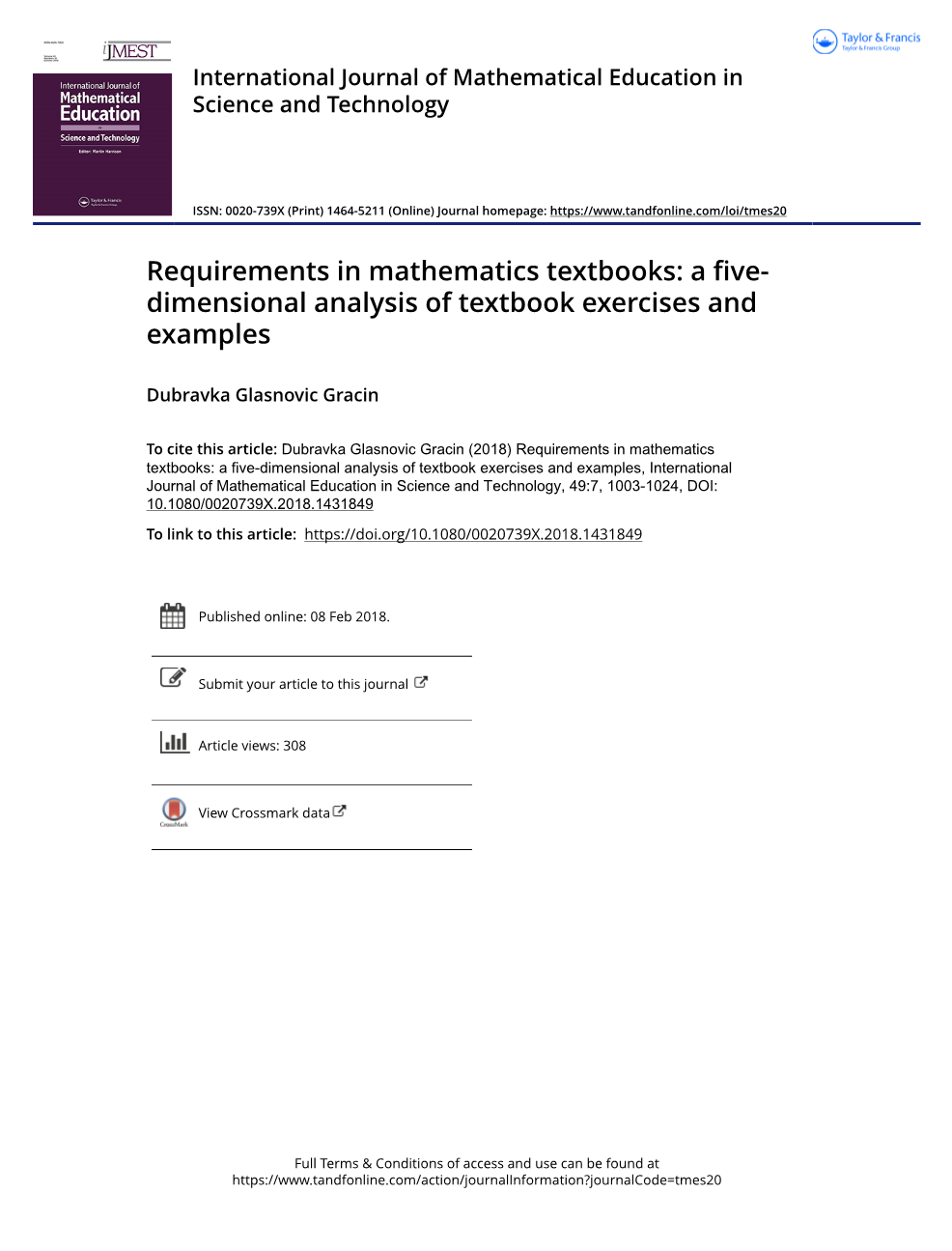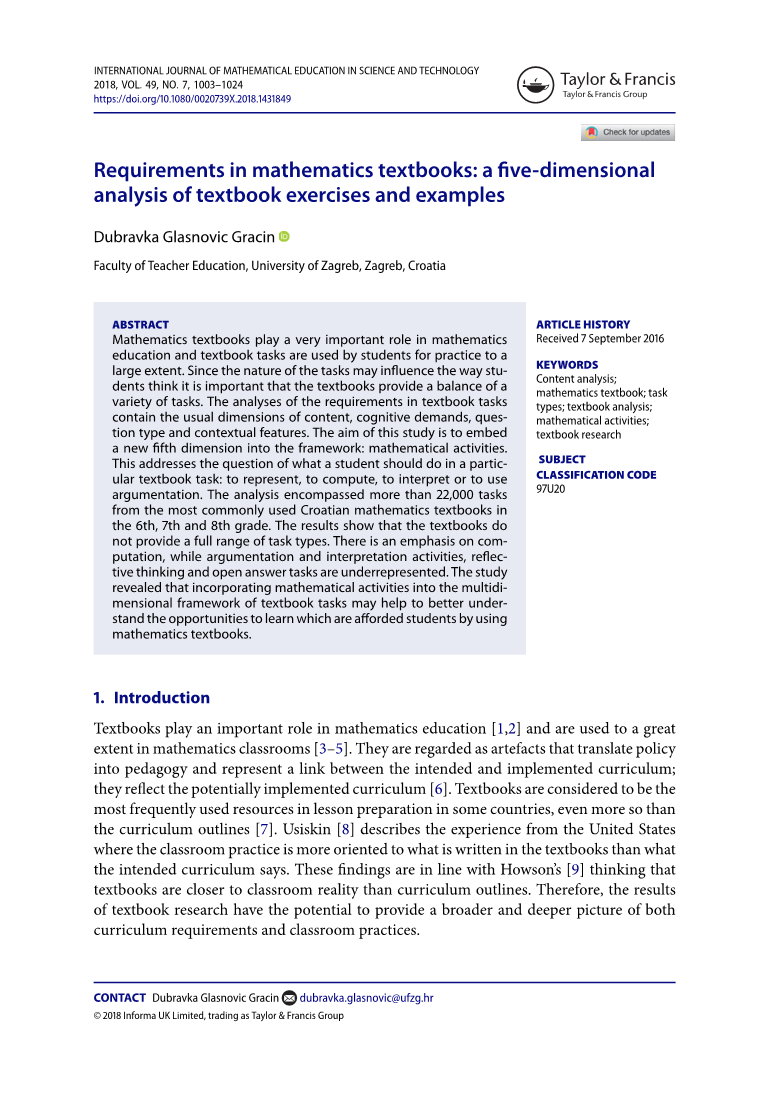本科毕业设计(论文)
外文翻译
Requirements in mathematics textbooks: a five-dimensional analysis of textbook exercises andexamples
作者: Glasnovic Gracin and Dubravka
国籍: Croatia
出处: International Journal of Mathematical Education in Science and Technology, 2018:1-22.
原文正文:
Abstract
Mathematics textbooks play a very important role in mathematics education and textbook tasks are used by students for practice to a large extent. Since the nature of the tasks may influence the way students think it is important that the textbooks provide a balance of a variety of tasks. The analyses of the requirements in textbook tasks contain the usual dimensions of content, cognitive demands, question type and contextual features. The aim of this study is to embed a new fifth dimension into the framework: mathematical activities. This addresses the question of what a student should do in a particular textbook task: to represent, to compute, to interpret or to use argumentation. The analysis encompassed more than 22,000 tasks from the most commonly used Croatian mathematics textbooks in the 6th, 7th and 8th grade. The results show that the textbooks do not provide a full range of task types. There is an emphasis on computation, while argumentation and interpretation activities, Reflective thinking and open answer tasks are underrepresented. The study revealed that incorporating mathematical activities into the multidimensional framework of textbook tasks may help to better understand the opportunities to learn which are afforded students by using mathematics textbooks.
Keywords: Content Analysis; Mathematics Textbook; Task Types; Textbook Analysis; Mathematical Activities; Textbook Research
1. Introduction
Textbooks play an important role in mathematics education [1,2] and are used to a great extent in mathematics classrooms [3–5]. They are regarded as artefacts that translate policy into pedagogy and represent a link between the intended and implemented curriculum; they reflect the potentially implemented curriculum [6]. Textbooks are considered to be the most frequently used resources in lesson preparation in some countries, even more so than the curriculum outlines [7]. Usiskin [8] describes the experience from the United States where the classroom practice is more oriented to what is written in the textbooks than what the intended curriculum says. These findings are in line with Howsonrsquo;s [9] thinking that textbooks are closer to classroom reality than curriculum outlines. Therefore, the results of textbook research have the potential to provide a broader and deeper picture of both curriculum requirements and classroom practices.
The research results indicate that textbooks are used to a great extent by students as a source of tasks, particularly practice exercises [3,4,7]. Generally, lsquo;the tasks are considered as devices for initiating activityrsquo; [10,p.238] and they create opportunities for learning mathematics [11]. Therefore, the nature of textbook tasks lsquo;can potentially influence and structure the way students think and can serve to limit or to broaden their views of the subject matter with which they are engagedrsquo; [12,p.525]. Thus, it is important that the textbooks and other curricular materials used in classrooms provide rich and worthwhile mathematical tasks. Stenmark [13] suggests some possible features of rich tasks, they should be: essential (fit into the core of the curriculum); authentic (use processes appropriate to the discipline); rich (lead to other problems); engaging (thought-provoking); active (learners construct meaning and deepen understanding); feasible (appropriate for learners); equitable (develop thinking in a variety of styles), and open (have more than one answer or approach). Many of the features mentioned connect rich tasks with high cognitive demands. Cognitive demand refers to the different kinds of thinking required in a task: memorization, procedures without connections to concept, procedures with connections to concept and doing mathematics [14]. Memorization involves reproducing rules or definitions, and procedures without connections require conducting algorithms which lsquo;have no connections to the concepts or meaning that underlie the procedure being usedrsquo; [14,p.348]. Procedures with connections develop deeper levels of understanding of mathematical concepts and ideas. Doing mathematics means requiring complex and non-algorithmic thinking with considerable cognitive effort. Memorization and procedures without connections to concept (e.g. formulas) may be characterized as low-level tasks, while the other two high-level tasks encompass lsquo;comprehension, interpretation, flexible application of knowledge and skills, and assembly of information from several different sources to accomplish work[15,p.171].
The need for lsquo;richrsquo; tasks means that mathematics textbooks should provide tasks that will engage students and challenge them to reason, as well as influence the quality of instruction and provide opportunities for developing understanding. This does not mean that there should be no low-level tasks in the textbooks or instruction. Vincent and Stacey [16] discuss how it is important lsquo;that students are presented with a balanced curriculum experience. The balance will need to be different for high and low achieving students, but all students need exposure to the full range of problem typesrsquo; ([16 ,p.103]).
The various features of different types of mathematical tasks mean that their analysis is complex. The purpose of this paper is to analyze the
剩余内容已隐藏,支付完成后下载完整资料


英语原文共 23 页,剩余内容已隐藏,支付完成后下载完整资料
资料编号:[276649],资料为PDF文档或Word文档,PDF文档可免费转换为Word


